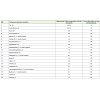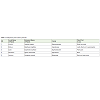Review Article
Fish Environment of Garhwal Himalaya- A Socio-Economic, Religious and Cultural Analysis
Kusum Dobriyal1 and Anoop Dobriyal2*
Corresponding author: Dr. Anoop Dobriyal, Department of Zoology, HNB Garhwal University (A Central University),Pauri Garhwal-246001, Uttarakhand, India,; E-mail: anoopkdobriyal@rediffmail.com
Citation: Dobriyal K, Dobriyal A. Fish Environment of Garhwal Himalaya- A Socio-Economic, Religious and Cultural Analysis. J Environ Soc Sci.2015;2(1): 112.
Copyright © 2015 Dobriyal K et al. This is an open access article distributed under the Creative Commons Attribution License, which permits unrestricted use, distribution, and reproduction in any medium, provided the original work is properly cited.
Journal of Environmental and Social Sciences | Volume: 2, Issue: 2
Submission: 03/06/2015; Accepted: 01/07/2015; Published: 19/07/2015
Abstract
Fish has a sacred place in Indian culture since time immemorial. It is honored as an incarnation of Lord Vishnu, cultured at home in aquarium to get rid of stress and have a peace of mind, reared in ponds and rivers for protein rich diet, becomes a cheap source of food for needy and poor rural folk and also has been an important source of economy to the country. A socio-economic, religious and cultural aspect of Garhwal region of Uttarakhand was under study for a period of two years. Apart from various issues like historical development in functioning of society, cultural changes and economic source alterations, certain issues were taken up which were observed to have greatest impact on human life of this region. In present communication one such issue, “Fish environment of Garhwal Himalaya- a socio-economic, religious and cultural analysis†has been taken up for discussion.
Keywords: Fish; Fishery; Environment; Economy; Culture; Problems; Perspectives
Introduction
Fish is worshipped as GOD in ancient Indian (Hindu) literature.It has been believed that God Vishnu’s first incarnated on earthwas as a fish - God Matsya for the welfare of people. The story islike this that during early days of shrishti (earth) a demon namedas Hayagreeva theft all important ancient literature and hidebeneath earth (Patal Lok). To save the earth and all importantancient literature, Lord Vishnu has to incarnate as Lord Matsya.During this passage he narrated several knowledgeable andeducative stories which were compiled in 291 chapters in theform of “MATSYA PURAN†[1,2]. Many of the stories are related toconservation of nature and natural resources. It has been statedand scientifically proved that just by keeping an aquarium inyour house you may skip many stressful diseases like high bloodpressure, insomnia, body pain, etc. [3,4]. According a scientific study [5] in 2009 conducted on the patients diagnosed withAlzheimer’s disease , it was observed that the patients exposed tothe aquaria averaged an increase of 17.2 percent in the amount offood they consumed. Weight also increased significantly, and thepatients required fewer nutritional supplements. The engineersof Vaastu shashtra believed that aquarium flashes out all negativeaspects of Vaastu by producing high positive energy [6].
The medicinal value of fish is well established. It is richin protein, vitamins, minerals and the leonelic acid whichis considered good for cardiac health. In Garhwal region aconsiderable rural population falls below the poverty lineand suffers from malnutrition. However fish which is cheaplyavailable for them provide them certain relief. In present papervillage life of Garhwal region in India, the wetland ecosystems,fish population dynamics and related socio-economic andcultural aspects are discussed here onwards.
Depiction of Fish in Religious Literatures
Vedas are considered as the most ancient literature of humancivilization, roughly estimated as about 8000 years old. Thefish is discussed in several occasions for different references[7] (Rigveda-7.18.06, 10.68.8,; Athrvaveda- 11.2.25; Yajurveda-24.11; Matsyapuran-24.41; Ramayana-3.73.15, 2.80.21;Mahabharata- Shanti parva, 265.09; Matsyapuran- 252.2, 285.6;Bhagwatpuran- 1.15.25). Diversified nomenclature of fish inancient literature is indicative of different species (Shalki, Pathir,Pathin, Meenasi, Visar, Animesh, jalchar, timidwaya, Neerniketanand paneeyniket, etc). In Amarkosh (1.10.17-20), the name of fishare given depending upon their specific characters [2]. These areMatsya (Madyati iti matsya- means as fish gives you pleasure- itis matsya), Jhash (Jhash hinsharthah-as it feeds on other fishes),Rohit (Raktawat- blood coloured), Singhatundah- due to lionmouth shaped and Mahashalka (Large scales- which we todaycall mahseer), etc.
Garhwal Region and its Rural Life
Garhwal region is situated between the latitudes 29o 26-ÙŽ31o 28 N and longitude 77o 49 - 80o 06 E with a total area ofabout 30,090 km2. Most of the holy rivers owe their origin to thesnow peaks of Chamoli and Uttarkashi Districts. Major riversare Alaknanda, originating from around Badrinath, Mandakini,originating from around Kedarnath, Bhagirathi from Gomukh-Gangotri, Pinder from Pindari glacier and many more spring fed streams. The pious Ganga is formed by the confluence ofAlaknanda and Bhagirathi at Devprayag. All these stream are richin fish and other aquatic biodiversity.
The rural life is hard in Garhwal region. Villages are mostlysituated nearby rivers or small stream for routine requirement.Agriculture do not support the entire need of people. Males of thefamily usually go outside for job work so that they can earn moneyand send to their family. In terms of economics it is referred asmoney order economy. Women of the family are hard working.Entire agriculture work is look after by them. Apart from thisthey rear animals (cow, buffaloes, oxen, goats and sheep’s) andequally contribute to the family economy. Location of most of thevillages is so close to water bodies that the children mostly catchsome fishes for their routine food requirement. In some families,one of the male members is doing a regular job of collecting fish.
Wetlands of Garhwal
As already stated the Garhwal region is full of natural aquaticecosystems. According to Dobriyal [8] there are two types ofstream in the region. The Snow-fed streams are Alaknanda,Bhagirathi. Bhilangana, Mandakini, Pinder, Nandakini,Vishnuganga, etc. These rivers have low water temperature andhigh velocity of water current [9-13]. The spring-fed streams areNayar, Khoh, Mandal, Song, Suswa and hundreds of their minortributaries. Various aspects of ecology of these streams arestudied [14-16].
Fish Population and Food Value
Garhwal hillstreams are full of aquatic life including fishes.The coldwater streams are enriched by schizothoracine andgolden mahseer fishery while the spring fed streams are richwith minor carps, loaches and catfishes [7,8,17,18]. Availablefish genera and their number of species along with food value ispresented in Table 1. Schizothorax sp (snow trout) is the majorfishery of region which contribute to about 70 % in quantum. Torfishery makes 2nd position being about 25 % in catch quantum.Crossocheilus and Garra are prominent among others [19].
Ecological Problems due to Anthropological Activities
The colourful fish fauna of these streams is under great threatdue to some human activities. Most important one is the dammingof the rivers at regular interval for power generation. This hasaltered the ecology of streams at a larger area. The feeding andbreeding grounds of fishes are under destruction. Mahseer is apotamodromous fish which locally migrates from large coldwaterrivers to upward spring fed stream for spawning. The unscientificdam planning has hampered the mahseer population. Anotherissue is of overfishing. Illiterate folk uses various unscientificmeans of fishing like use of bleaching powder, electric shocks andtoxic plants [Table 2]. This is doing great loss to fishery. Someuniversity researchers are running some ecological awarenessprograms but the intervention or action at Government level isurgently required.
Possibilities for Conservation
It is required to make in-situ and ex-situ conservation ofaquatic biodiversity. Migration passage should be allowed whiledamming the stream. Overfishing should be completely banned.Fish hatcheries and nurseries be established at the river banks.Induced breeding programmes through use of new generationdrugs (Ovaprim/ovatide etc) are necessary. And finally extensiveecological awareness program is needed to be launched.
References
- Matsya Puran (Uttar Bhag) (1910) Translator Ram Pratap Tripathi, Hindi Sahitya Sammelan, Prayag, Allahabad. P. 585.
- Dileep Kumar et al. (2010) Bharat ke Prachin Granthon main uplabdha Matsya evam matsyiki. CIFE Mumbai, Published by Narendra Publications Delhi. P 141.
- http://www.theaquarium101.com/multiple-benefits-aquarium/.
- www.aquariumsbydesign.ca/education.php.
- en.wikipedia.org/wiki/Aquarium therapy.
- 6.www.vastushastraguru.com/vastu-fish-aquarium.
- Dobriyal AK (1991) An appraisal of the fishery resource of riverine ecosystems of Garhwal, Central Himalaya. In: Bhatt, S.D. and Pandey, R.K. (Ed.). Ecology of Mountain waters. Ashish Publishing House, New Delhi. Pp. 306- 312.
- Dobriyal AK, Kumar N (1988) Fish and fisheries of the river Mandakini. In: R.D. Khulbe (ED.) Perspectives in Aquatic Biology. Papyrus Pub Co., New Delhi. Pp. 337-340.
- Dobriyal AK, Negi KS, Joshi H, Bisht MS (2003) Water quality and biodiversity of a high altitude river from Uttaranchal. Proceedings of XIIth National Symposium on Environment. HNB Garhwal University Campus, Tehri Garhwal pp. 493-496.
- Bisht KL, Dobriyal AK, Bisht MS, Joshi H, Singh HR (2005) Fisheries ecology of the high altitude river Pinder from Garhwal Himalaya. Biological Diversity in Freshwater Environments (Ed.) Nautiyal P, Bhatt JP, Gusain OP, Dobriyal AK. Transmedia, Srinagar Garhwal: 242-248.
- Nautiyal P, Dobriyal AK, Chaukiyal DC, Singh (1986) HR Quality and potability of Alaknanda water at Srinagar Garhwal with a note on bacterial density as an indicator of pollution. Poll Res 5: 143-145.
- Khanna DR, Badola SP, Singh HR, Dobriyal AK (1992) Observations on seasonal trends in diatomic diversity in the river Ganga at Saptsarovar, Hardwar. In: Sehgal KL (Ed.) Recent Researches in Coldwater Fisheries. Today and Tommorrow Printers and Publishers, New Delhi pp. 99-107.
- Singh HR, Badola SP, Dobriyal AK (1982) Ecology of the river Nayar of Garhwal Himalaya. Uttar Pradesh J Zool 2: 72-76.
- Pokhriyal RC, Dobriyal AK, Singh HR (1983) Seasonal variation in physicochemical parameters of the stream Khandagad. Uttar Pradesh J Zool 3: 70-72.
- Dobriyal AK (1985) Ecology of limnofauna in small streams and their importance to the village life in Garhwal Himalaya. Uttar Pradesh J Zool 5: 139-144.
- Kumar K, Rautale KK, Bisht KL, Joshi VD, Rautela AS, et al. (2006) Ecological studies on the biodiversity of river Khoh in the foot-hills of Garhwal Himalaya: Part I. Phytoplankton analysis. Journal of Nature Conservators 18: 71-80.
- Singh HR, Badola SP, Dobriyal AK (1987) Geographical distributional list of ichthyofauna of Garhwal Himalaya with some new records. J Bombay Nat Hist Soc 84: 126-132.
- Dobriyal AK, Bahuguna AK, Kotnala CB, Kumar N, Singh HR (1992) Ecological studies on the fish and fisheries of the river Nayar. In: Sehgal KL (Ed.) Recent Researches in Coldwater Fisheries. Today and Tomorrow Printers and Publishers, New Delhi Pp. 93-98.
- Dobriyal AK, Singh HR (1988) Ecological basis for the ichthyofaunal variation in two hill strteams of Garhwal Himalaya. In: M. Mohan Joseph (Ed.) The First Indian Fisheries Forum Proceedings. Asian Fishery Society, Indian Branch. 313- 317.


